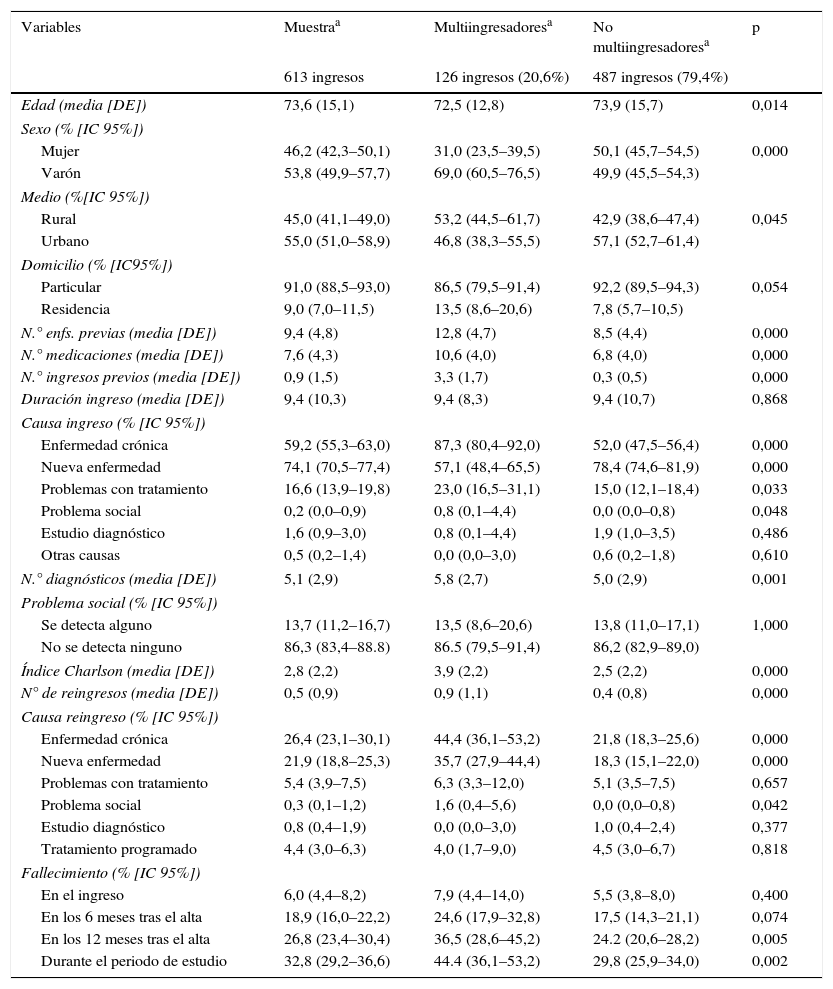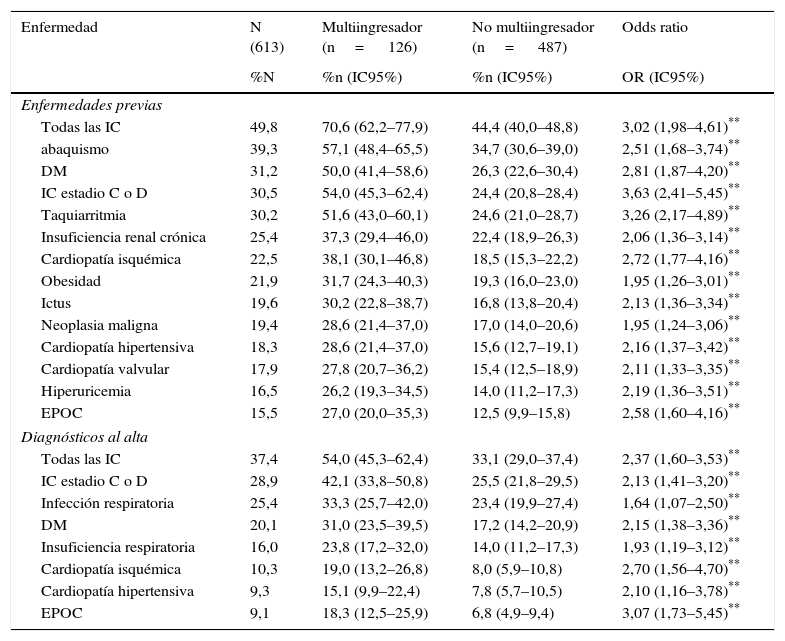El paciente multiingresador origina un gran consumo de recursos sanitarios. Hemos estudiado los factores asociados con el ingreso hospitalario múltiple en una cohorte de pacientes asistidos en un Servicio de Medicina Interna.
Pacientes y métodosSe analizaron 613 ingresos hospitalarios consecutivos. Se definió como paciente multiingresador a aquel que al ingresar contabilizaba 3 ingresos o más en los últimos 12 meses. Se analizó la relación de factores demográficos, clínicos y sociales con la característica de ser multiingresador. Además, se analizó el reingreso en los 6 meses siguientes al alta así como el fallecimiento en el ingreso y en los 6 y 12 meses siguientes al alta.
ResultadosLos multiingresadores se caracterizaron frente a los no multiingresadores por ser de sexo masculino, ser más jóvenes y presentar mayor comorbilidad, mayor consumo de medicaciones y mayor puntuación en el índice de Katz. La principal causa de ingreso de los multiingresadores fue la «descompensación de una enfermedad crónica» (87,3%). Las enfermedades que se asociaron de forma más destacada con el multiingreso fueron la insuficiencia cardiaca, la diabetes mellitus y la enfermedad pulmonar obstructiva crónica. En los 6 primeros meses tras el alta los multiingresadores presentaron más reingresos. Durante el periodo de estudio, falleció el 40,4% de los pacientes multiingresadores y el 28,8% de los pacientes no multiingresadores.
ConclusionesLos pacientes multiingresadores presentaron mayor complejidad clínica que los no multiingresadores, y el multiingreso se asoció con las enfermedades crónicas, la polifarmacia, el deterioro funcional y tasas elevadas de mortalidad.
Patient who require multiple hospitalizations result in a considerable consumption of healthcare resources. In this study, we analyzed the factors associated with the multiple hospitalizations of a cohort of patients treated at a department of internal medicine.
Patients and methodsA total of 613 consecutive hospitalizations were analyzed. A multiple-hospitalization patient was defined as one who at the time of admission had been hospitalized 3 or more times in the past year. We analyzed the relationship between demographic, clinical and societal factors on one hand and having been hospitalized on multiple occasions on the other. We also analyzed readmissions in the 6 months after discharge, as well as mortality during the hospitalization and in the 6 and 12 months after discharge.
ResultsWhen compared with patients who have not been hospitalized on multiple occasions, multiple-hospitalization patients are more likely to be male, younger and to have greater comorbidity, greater consumption of medicines and higher Katz Index scores. The main cause for admission for multiple-hospitalizations patients was chronic disease decompensation (87.3%). The diseases that were most obviously associated with multiple hospitalizations were heart failure, diabetes mellitus and chronic obstructive pulmonary disease. In the first 6 months after discharge, multiple-hospitalization patients had a greater number of readmissions. During the study period, 40.4% of the multiple-hospitalization patients died, and 28.8% of the nonmultiple-hospitalization patients died.
ConclusionsMultiple-hospitalization patients have a greater clinical complexity than nonmultiple-hospitalization patients, and multiple hospitalizations are associated with chronic diseases, polypharmacy, functional impairment and high mortality rates.
Article
Diríjase desde aquí a la web de la >>>FESEMI<<< e inicie sesión mediante el formulario que se encuentra en la barra superior, pulsando sobre el candado.

Una vez autentificado, en la misma web de FESEMI, en el menú superior, elija la opción deseada.

>>>FESEMI<<<








